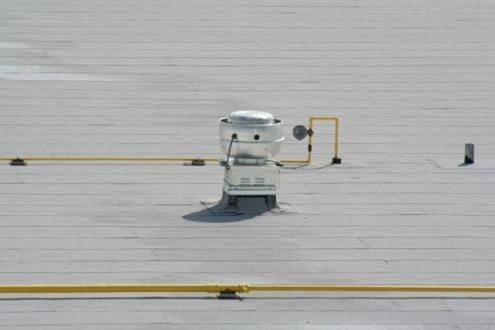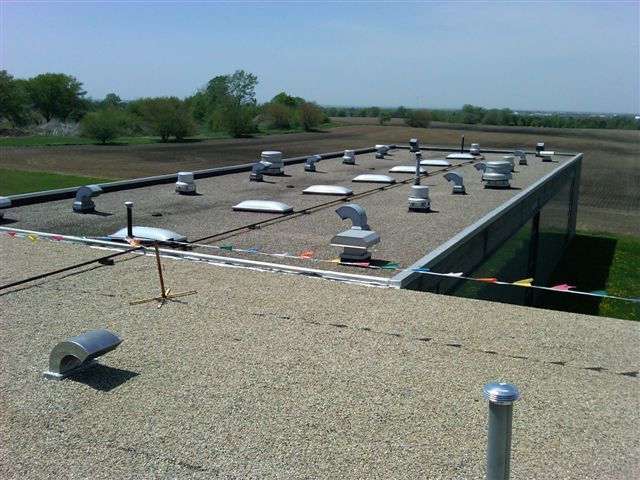Commercial Roof Types
The investment of a quality commercial roof reflects the entire building’s value, so smart business owners need to do their homework before choosing a roofer. Kreiling has been serving the commercial roofing needs of businesses in the Peoria area since 1921. We service commercial roof repair, new installation, and replacement and maintenance.
EPDM (Ethylene Propylene Diene Monomer) is a rubber roof system designed to create a smooth, clean surface on your roof that's both quicker and cheaper to install than a traditional roofing solution like BUR or Modified Bitumen. While the rubber membrane of EPDM roofs come in different thicknesses, EPDM systems generally consist of a layer of insulation, a single ply membrane, flashings and adhesives/fasteners.
Advantages
- Comes in large rolls, which means fewer seams than other single-ply roofing systems
- Pliable membrane making installation quick and easy with just adhesives, fasteners and rollers
- Oldest type of single-ply system and has been used in the field for over 40 years
- Less expensive than traditional BUR
Considerations
- Walk pads are recommended for foot traffic because EPDM is susceptible to punctures by sharp objects
- Regular maintenance is common in aging roofs to repair seals and other water entry points
TPO (Thermoplastic Polyolefin) and PVC (Polyvinyl chloride) are both single-ply systems and are direct alternatives to EPDM. Thanks to their affordability and ability to often meet many environmental building standards, both have gained in popularity in recent years. Like EPDM, TPO & PVC systems consist of a layer of insulation, a single ply membrane, flashings and adhesives/fasteners. The difference is that TPO and PVC both have the seams heat-welded together, while EPDM must be attached with a special adhesive tape.
Advantages
- Seams are heat-welded forming a water resistant barrier
- TPO & PVC are often installed in white, which increases the roof's UV light reflectivity, keeping the building cooler than a dark roof like BUR, Mod Bit or traditional EPDM
- Fast installation
- More affordable than labor intensive roofing systems like BUR
Considerations
- TPO has only existed for about 15-20 years, but manufacturers have already gone through numerous revisions to the types of material used during manufacturing due to membrane and seam failures. Great progress has been made recently, but the long-term track record isn't there
- Shrinkage to the membrane can occur, requiring seams and flashing to be sealed to prevent leaks.
- Installation requires highly skilled and experienced roofing contractors to ensure proper installation and welding of the seams.
Modified bitumen roofs are seen as the modern alternative to BUR roofs. While a BUR roof is installed by rolling down a membrane and then covering with bitumen (think of it as an asphalt-like substance), a modified bitumen roof combines the membrane and the bitumen into a single roll, which is often covered with colored granules. Depending upon which type of modified system is used, this type of roof can either be applied with heat or cold adhesive. Once the material is laid down, the seams are fused together to create a seamless roof covering. A modified bitumen roof has all the advantages of a BUR roof, but allows for the roofing contractor to install the roof without worrying about VOCs and other fumes. For that reason, modified bitumen is a great option when re-roofing a building that will have occupants during the installation process.
Advantages
- Double layer provides added durability against weather, debris and foot traffic puntures
- No VOCs given off during installation
- Seams are heat-welded to ensure no gaps for moisture
- Lower labor costs than BUR
Considerations
- Higher material cost
- Installation requires highly skilled and experienced roofing contractors to ensure proper installation
Built-up roofs (aka BUR or tar and gravel) consist of multiple, alternating layers of bitumen (i.e. asphalt, tar, etc) and roofing felt membrane which are finished with gravel or other asphalt based coating.
Advantages
- One of the oldest types of commercial roofing material with decades of strong performance
- Excellent durability against weather and storm damage
- Very low maintenance
- More durable for rooftop traffic
Considerations
- Typically more expensive due to more intensive labor
- Longer installation time
- Installation tends to give off VOCs, which can impact the building below




